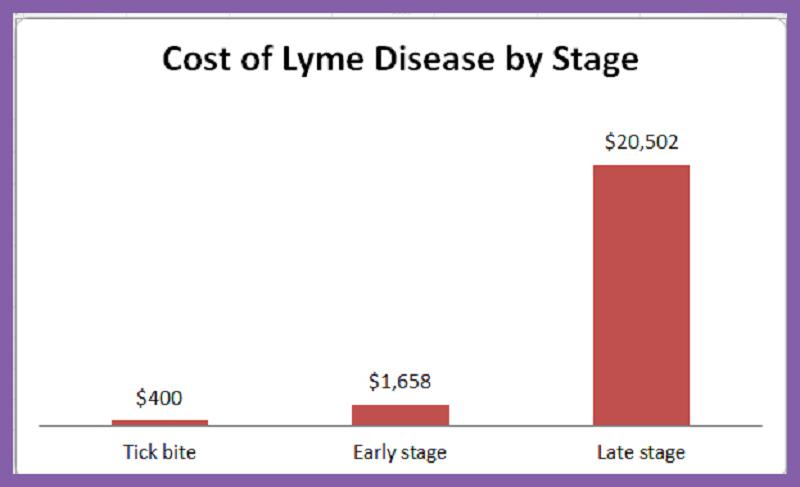LYMEPOLICYWONK: Is an ounce of prevention worth a pound of cure? Or is it too little too late for those who are sick today?

When the CDC increased its surveillance numbers from 30,000 to 300,000, they said the increased case numbers meant we needed to do more about prevention and their emphasis is on avoiding the tick bite. But is prevention in the form of tucking your pants in on the hike, enough? Not by a long shot.
Here’s the thing. In healthcare, there are actually three types of prevention in disease: primary, secondary and tertiary. The whole package involves avoiding and treating the bite (primary prevention), early diagnosis and treatment of disease (secondary prevention), and finally treating to improve quality of life and hopefully cure (tertiary prevention). Why is the CDC only discussing primary prevention? It’s the tip of the iceberg.
The cost of Lyme disease goes up exponentially with treatment delay.These costs need to be addressed. It’s much more cost effective to treat the tick bite and intervene for early diagnosis and treatment at the earliest opportunity than it is to wait. And leaving patients with chronic Lyme illness is exorbitantly costly and ethically unacceptable.
See what I am talking about? The chart below is taken from Zhang’s data on the cost of Lyme disease published in 2006 adjusted for inflation.
If you ask patients what they care about when they have a tick bite or early Lyme disease, they will tell you that first and foremost they do not want to get chronic Lyme. This is the outcome that patients care about.
You do this by:
- Treating the tick bite aggressively (like we treat early Lyme disease) to avoid contracting Lyme disease
- Early diagnosis and treatment to cure
Most patients with chronic Lyme are not diagnosed within six months. We need to increase awareness to increase diagnosis. We need to stop telling people “there is no Lyme” here.
To make matters worse, the current failure rate for IDSA protocols is estimated to be between 25-35%. Aucott’s most recent study identified and treated patients on EM rash, but 35% failed treatment. More aggressive protocols are needed to increase cure rates and prevent chronic Lyme from developing. Why aren’t the CDC and NIH focusing on this? These are the outcomes that matter to patients.
As Pam Cocks, managing editor of the Lyme Times puts it: “They are turning a treatable condition into a chronic one, with devastating personal and economic consequences for the patient, their care givers, and the country.”
Chronic Lyme disease exacts a personal and economic toll. The annual cost is a staggering $20,502–this includes medical costs and nonmedical costs (travel etc) as well as loss of productivity. The loss of productivity in this disease is 54% of all of the costs. These costs reflect days of work missed due to illness. Loss of productivity affects the patient, their family, their employer, and society at large when patients are forced to go on disability or cut back their hours of work. It is reflected in lost tax revenues and gross domestic product for the US government.
We need to develop better treatment to improve quality of life for those with chronic Lyme disease and get people back to work and able to do what they used to do. Most of the cost of Lyme is due to chronic Lyme disease. That $20,500 a year is not a one-time cost, it repeats year after year until that person is restored to their lives, their work, and society through improved care. Why isn’t this on the CDC’s agenda?
So, yes, we need prevention in the form of tucked in pants, but we need a lot more. We need to treat the bite aggressively, we need to ensure early diagnosis and treatment to cure, and we need to develop innovative treatments for those with chronic Lyme disease.
The LYME POLICY WONK blog is written by Lorraine Johnson, JD, MBA, who is the Chief Executive Officer of LymeDisease.org, formerly CALDA. Contact her at lbjohnson@lymefaces.com.
Resources:
The CDC discusses primary, secondary, and tertiary prevention in the context of skin cancer here.
I explored this topic in my speech at Senator Gibson’s hearing.
The CDC press release acknowledges the increased case numbers and urges prevention rather than early diagnosis and improved treatment.
Zhang X, Meltzer MI, Pena CA, Hopkins AB, Wroth L, Fix AD. Economic impact of Lyme disease. Emerging infectious diseases. 2006 Apr;12(4):653-60. (Zhang’s costs are based on the year 2002. This blog has adjusted those for inflation through 2012).
Aucott JN, Rebman AW, Crowder LA, Kortte KB. Post-treatment Lyme disease syndrome symptomatology and the impact on life functioning: is there something here? Qual Life Res. 2013 Feb;22(1):75-84.









We invite you to comment on our Facebook page.
Visit LymeDisease.org Facebook Page